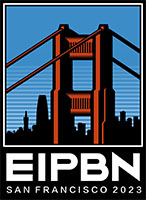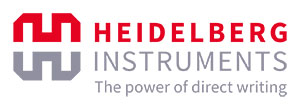Women In Nanofabrication (WIN)
WIN is a networking event that brings together women (and non-binary) professionals in science and industry from around the world to exchange ideas through diversity and inclusion to advance the fields of lithography and nanotechnology. For more information about the WIN community, please join the EIPBN Women in Nanofabrication Group.
2023 Women in Nanofabrication Lunch
- Help us honor Stella Pang for her long-term commitment to EIPBN
- Participate in Early Career Panel Discussion
- Enjoy lunch
Early Career Panel Discussion
What women early in their careers think they need to be successful
Moderator: Carla Perez-Martinez

Victoria Ravel
(Student)
George Washington University

Leeya Engel
(Assistant Professor)
Technion – Israel Institute of Technology

Jana Chaaban
(Industry)
Heidelberg Instruments Nano

Sarah Robinson
(Government)
National Institute of Standards and Technology
Women in Nanofabrication Lunch
Date: Thursday, June 1
Time: 12:00 pm - 1:30 pm
Location: Continental 8 & 9
WIN Monthly Meetings
The WIN meetings were launched virtually through EIPBN Gather Town during EIPBN 2021 and are ongoing. Recently, we held these monthly meetings virtually as a ZOOM meeting starting 10 minutes past the hour; however the EIPBN Gather Town room is still available for our community to engage in a private space. If you were a registered WIN attendee at EIPBN 2021 or EIPBN2022, then you already have access to the Gather Town website. You can also get access by registering for the EIPBN 2023 in San Francisco. The hour-long meetings typically take place on the first Friday of each month at 7:10 am PST. Look below for a complete list of meeting dates and speakers. Please sign up for each meeting that you plan to attend using the links in the table below.
WIN welcomes volunteers to share your career experiences and insights or present a technical talk about your research. Please contact Martha Sanchez at martha_sanchez@amat.com for questions or to enroll and include WIN@EIPBN-Gather/Volunteer in the subject line. Talks should not exceed 15 minutes. Please contact Gina Adam at ginaadam@gwu.edu if you experience registration and/or technical issues when accessing Gather.town.
WIN New Meeting Series Speakers
Meeting Location: Virtual Meeting
Time: 7:10 AM PST, 10:10 AM EST, 3:10 PM London, 10:10 PM Beijing
After our February and March round table discussions regarding “Career mentoring in academia, government & industry: what are your needs?” and the timely topic of “Research and education initiatives for CHIPS Act”, our previously invited and announced speakers of these events will be rescheduled at a later time.
Please find the latest updates below.
| Meeting Date | Speaker | Title | Sign Up |
|---|---|---|---|
| September 1, 2023 | Kirsten Moselund (PSI) | Title: A career in semiconductors - electrons, photons and qubits | Sign Up Here |
| October 6, 2023 | Teri Odom (click to view bio) | Title: Follow the Nano-brick Road | Sign Up Here |
Past Meeting Series Speakers
| Meeting Date | Speaker | Title |
|---|---|---|
| August 4, 2023 | Marianna Sledzinska (Catalan Institute of Nanoscience and Nanotechnology, Spain) |
Title: Title
Fabrication techniques for phonon engineering in low dimensional materials Abstract: The central concept in phononics is the tuning of the phonon dispersion relation, also called phonon engineering, which provides a means of controlling related properties such as group velocity or phonon interactions. In this talk I will revise experimental achievements in the fabrication and application of 2D phononic crystals enabling the modification of the phonon dispersion relation of surface and membrane modes for the control of elastic waves/phonons propagation. These artificial materials offer the potential of modifying and controlling the heat flow to enable new schemes in thermal management. |
| July 7, 2023 | Joint WIN+WAVES meeting | Networking event with an informal discussion “Enhancing professional visibility by networking via networks” |
| April 7, 2023 | Guest Chair: Natalya Kublik (Arizona State University) | Young Investigators |
| Beihang Yu (ostdoc at the Berkeley Lab, working with Dr. Ricardo Ruiz and Dr. Ron Zuckermann) | Title: Bioinspired, sequence-defined polymer brushes as patternable surface modification monolayers for semiconductor/bio interfaces | |
| Petrovic Jelena (PhD in microtechnology and currently a Scientist Postdoc ETH Zurich and Paul Scherrer Institute, Switzerland with Lucia Romano) | Title: Microstructured fiber-based probes for application in optogenetics | |
| Adan Azem (University of British Columbia, Canada) | Title: Infrared waveguide integrated superconducting nanowire single-photon detectors (work in progress) | |
| May 5, 2023 | Elena Pinilla-Cienfuegos (Centro de Tecnología Nanofotónica de Valencia, Universidad Politécnica de Valencia) |
Title: Accurate & Reproducible Method for Single Nanoparticle Positioning on Nanostructures
View Abstract |
| Jan. 6, 2023 | Leeya Engel (Assistant Professor, Faculty of Mechanical Engineering, Technion - Israel Institute of Technology) |
Title: "There is no single track to the tenure track: my experience from PhD and Postdoc to Assistant Prof."
Bio: Leeya Engel is an Assistant Professor of Mechanical Engineering at the Technion – Israel Institute of Technology. Her research interests lie at the interface of microfabrication and biology (bio-MEMS). Leeya received her B.Sc. in physics from The Hebrew University of Jerusalem, Israel in 2008 and her Ph.D. in materials engineering and nanotechnologies in 2016 from Tel Aviv University, Israel. Leeya’s doctoral work focused on developing electroactive polymer micro-actuators and was recognized by several research awards including the AVS Nellie Yeoh Whetten Award. Leeya completed her postdoctoral studies at Stanford University in 2022. At Stanford, Leeya developed new bio-MEMS and pioneered the use of micropatterning for cryo-EM of cells. Her lab continues to engineer the cell microenvironment to understand how life works at the nanoscale. |
| Dec. 2, 2022 | Carla Perez Martinez (UCL) |
Title: Using rockets in nanomanufacturing
Abstract: The ionic liquid ion source (ILIS) was originally proposed as a device for space propulsion. In an ILIS, a beam of ions is produced from an ionic liquid, or room temperature molten salt, by using electric fields. In this talk, I give an overview of the application of ILIS in space thrusters and motivate the use of ILIS to treat materials. The many chemistries made available by ionic liquids could be of advantage for material etching, in focused ion beams, and for material deposition. Bio: Carla Perez Martinez is a UKRI Future Leaders Fellow at the London Centre for Nanotechnology at University College London. Carla obtained her BS, MS and PhD degrees from MIT in 2011, 2013 and 2016, respectively. For her undergraduate and graduate research, Carla worked with Prof Paulo Lozano in the MIT Space Propulsion Lab, developing ionic liquid ion sources. After her PhD, she moved to the UK to take up a postdoctoral position in the group of Prof Susan Perkin in the Physical and Theoretical Chemistry Laboratory at the University of Oxford, where she was also appointed Junior Research Fellow at Trinity College. At Oxford, Carla studied ionic liquids and electrolytes under nanoconfinement, in particular, the response of these substances when subjected to electric fields. In January 2020, Carla moved to the London Centre for Nanotechnology with funding from UKRI to set up her own group, to develop new nanomanufacturing technologies based on ionic liquid ion source. |
| Nov. 4, 2022 | Updates from our young investigators |
Afshan Begum, National Institute for Materials Science and University of Tsukuba (Japan) - Fabrication of large array photonic crystals to observe double Dirac-cones materialized by accidental degeneracy
Alba Arroyo-Fructuoso, University of Valencia (Spain) - Modulation of the Critical Current Induced by an Electric Field in Superconducting Nanowires Grown by He+ FIBID Sarah Spector, Massachusetts Institute of Technology (USA) - Nonplanar Nanofabrication via Interface Engineering Mengdi Bao, Rochester Institute of Technology (USA) - Simple, Sensitive and Instrument-free Detection of Viral Nucleic Acids Victoria Ravel, George Washington University (USA) - Dual-compartment microelectrode array for investigation of neuronal network media exchange |
| Oct. 7, 2022 | Farnaz Niouri (MIT) |
Engineering at the Limits of the Nanoscale
View Abstract & Bio |
| Sept. 2, 2022 | Sijia Xie (Shanghai Industrial mTechnology Research Institute (SITRI), Shanghai, China) | Hybrid structures by direct write lithography—Tuning the contrast and surface topography of grayscale photoresist with nanoimprint (JVSTB- EIPBN 2022 Best Paper Award) |
| Aug. 5, 2022 | Theda Daniels-Race (LSU) | One of These Things is Not Like the Others: An African-American Woman's Journey to the Academy |
| July 2, 2022 | Jessica Andriolo (Montana Technological University and Alpha Technology, LLC) | Applied Nanoscale Solutions for the Environment, Medicine, and Materials Fabrication |
| May 6, 2022 | Grande walk: Highlight on students and postdocs posters | Poster session and Exhibition Hall EIPBN 2021 |
| Apr. 1, 2022 | Dr. Lucia Romano (ETH Zurich; Paul Scherrer Institute; and University of Catania) | Gas phase MacEtch: unparalleled high aspect ratio silicon nanostructures |
| Mar. 4, 2022 | Dr. Rosa Córdoba Castillo (Universitat de València) | How I went from PhD to junior lead researcher |
| Feb. 4, 2022 | Helen Kardan, ASML | My career path through the cultures |
| Jan. 7, 2022 |
Dr. Alexandra Joshi-Imre (University of Texas at Dallas) Yutika Badhe (University of Texas at Dallas) |
Microfabrication of neural interface electrode arrays for chronic in-vivo applications Stretchable electronics based on a nanofiber reinforced soft composite material |
| Dec. 3, 2021 | Dr. Elizabeth A. Dobisz (Senior Consultant at SLAC National Accelerator Laboratory) | My example of a career path in Nanofabrication |
| Nov. 5, 2021 | Dr. Anuja DeSilva (Lam Research) | My career path learnings in Semiconductor Research: How to persevere and advocate? |
| Oct. 1, 2021 | Natalya Kublik (Arizona State) | Increasing density of additively manufactured copper parts utilizing solid-nanoporous hybrid feedstock with higher energy absorption properties |


